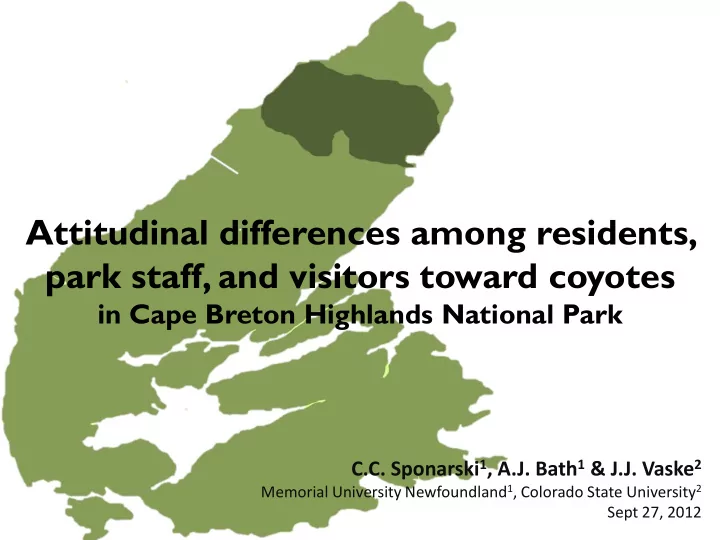

Attitudinal differences among residents, park staff, and visitors toward coyotes in Cape Breton Highlands National Park C.C. Sponarski 1 , A.J. Bath 1 & J.J. Vaske 2 Memorial University Newfoundland 1 , Colorado State University 2 Sept 27, 2012
Background
Background • Coyotes naturally dispersed into the park in the 1970s • Higher frequency of human-coyote interaction (HCI) since 2000 • Only coyote cause human fatality in North America occurred in 2008
Study Area Cape Breton Highlands National Park
Research Questions Are there differences among local residents, park staff, and visitors in their … a) Attitudes toward b) Fear of c) Likelihood of d) Control over coming into contact with coyotes
Goal – Challenge – Solution • Goal of Human Dimensions research – Conceptualize, measure and interpret variables and their relationships in a way that bears meaning on problems of managerial or scientific interest • Challenge – Effectively communicating the meaning of abstract statistics (e.g., standard deviation, standard error) for measuring consensus • Solution – Potential for Conflict Index (PCI 2 )
Potential Conflict Index (PCI 2 ) Integrates into one measure information about: • Central tendency • Dispersion • Shape of a distribution Uses graphic display: Easy interpretation Places findings in managerial context (e.g., the acceptability of a given mgmt. action)
Assumptions (PCI 2 ) Index range: 0 ---------------------------------------- 1 (no conflict/ to (most conflict/ most consensus) least consensus) No conflict (PCI 2 = 0) occurs when: 100% rate mgmt. action in a single category ( e.g., 100% “Highly Unacceptable” OR 100 % “Highly Acceptable” )
Example PCI 2 Highly Larger bubbles reflect more potential for conflict 3 Acceptable 2 0.36 1 0.63 0.58 Neither 0 -1 -2 0.13 0.14 0.06 0.08 0.05 0.04 Highly -3 Unacceptable Wolf Raccoon Bear Presence Nuisance Kills Human
Methods 1. Residents ( n =578; 72% return rate) Mail-out questionnaire 2011 2. Parks Staff ( n =124; 85% return rate) Internally distributed questionnaire 2011 3. Visitors ( n =375; 51% return rate) Trail interviews & mail back questionnaire 2011 & 2012
Attitudes toward Coyotes Do you think of coyotes as … Good, 1 3 Beneficial, Positive 2 1 a a 0.13 0.17 a 0.22 0 Neither b a 0.21 0.23 b 0.31 b -1 0.20 a 0.21 b 0.30 -2 Bad, Harmful, -3 Good or Bad? Beneficial or Positive or Negative Harmful? Negative? Visitors Park Staff Resident
Fear toward Coyotes I fear for … 1 Strongly 3 Agree 2 b 0.31 ab 0.20 b 0.47 1 b 0.38 Neutral 0 a 0.65 b b 0.35 0.49 -1 b 0.38 a 0.20 ab 0.28 -2 a 0.27 a 0.17 Strongly -3 Disagree My own My children’s The spread of My pet’s personal health or disease by health or health or safety. coyotes. safety. safety. Park Staff Resident Visitors
Likelihood of HCI The likelihood of the following event occurring to you while in the park… Extremely 3 Likely 2 a 1 0.38 b 0.49 Neither 0 b 0.57 a 0.53 b 0.45 c 0.44 -1 b 0.36 a 0.25 -2 c 0.15 Extremely -3 Unlikely Being S eeing a Being approached approached by coyote. by a coyote, a coyote. snarling. Park Staff Resident Visitors
Control over HCI How much control do you feel have from preventing the following form occurring while in the park … 1 Complete Complete 3 Control Control 2 1 a a 0.37 0.39 Neither Neither 0 ab 0.41 a 0.41 a 0.44 -1 ab 0.39 a 0.39 b 0.43 b 0.33 -2 No No -3 Control Control Being approached Seeing a Being by a coyote, coyote approached by snarling. a coyote. Resident Visitors Park Staff
Summary Residents generally … Held more negative attitudes toward coyotes Reported more fear Felt a higher likelihood and in less control of coming into contact with coyotes while in the park
Summary Park Staff generally fell in between the opinions of the local resident and visitors Visitors generally … Held more positive attitudes toward coyotes Reported the least amount of fear Felt a lesser likelihood and in more control of coming into contact with coyotes while in the park
Acknowledgements CBHNP: Erich Muntz, Derek Quann, & Mariève Therriault Funding: Parks Canada, SSHRC, Memorial University Photography: Laura Barisonzi (www.barisonzi.com) Research Assistants: Irene Borelli, & Maggie Sutherland
Questions?
Recommend
More recommend